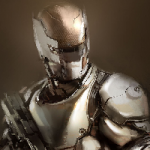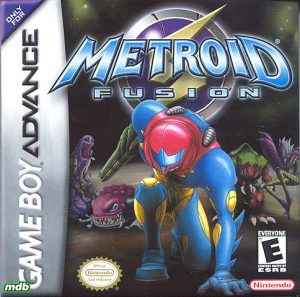 Review by: Asaic
Review by: Asaic
Original Publish Date: Pending
Final rating: As a Metroid sequel: 9.5/10
As a stand-alone game: 9.5/10
 After an excruciatingly long hiatus, Samus finally returns. Was it worth the wait? You bet it was.
After an excruciatingly long hiatus, Samus finally returns. Was it worth the wait? You bet it was.
Metroid Fusion is remarkable. It is a totally unique game that manages to hold onto everything that made the Metroid series great. It is the perfect sequel to its predecessors from start to finish.
Control
Just when you think it can’t get any better than Super Metroid, they give us Metroid Fusion. Previously, the third Metroid installment and a few other games (such as Castlevania: Symphony of the Night) were the leaders when it came to solid 2D play control. Now there is a new champion. Think Super Metroid, but with a few more moves, increased speed and even more precise and responsive control.
Nintendo did a great job porting the general play mechanics of Super Metroid to the Game Boy Advance. Having the R button as the key to firing missiles instead of the select button is the perfect compliment to the faster gameplay in Metroid Fusion. Using the select button wouldn’t have worked too well in those heated boss battles. About the only complaint I have is that I would have swapped the L and R buttons, or at least made a configuration option like Super Metroid had. Otherwise, the control is as good as it could possibly get.
Gameplay
This is the department where Metroid Fusion shines most. The pacing is perfect all the way through. With the brilliant addition of grabbing ledges and climbing ladders, it adds to the already exceptionally smooth gameplay that Super Metroid offered us nearly a decade ago. From the exploring to the boss fights, the pacing and precision never let up.
One of the main differences in Metroid Fusion is the increased damage that Samus takes. It is not uncommon to lose more than 100 units of energy in a single hit. Most normal creatures in the game will drain you anywhere from 30 to 70 units, and the suit upgrades only reduce damage by 5% of the base damage, each. Early on you will notice that this game is far less forgiving than the previous installments. This is only amplified in the somewhat difficult boss fights — that is, until you find out how to exploit their weak points efficiently, then the game becomes quite easy. I am reminded of games such as Contra and Ninja Gaiden; once you’ve learned how the enemies work and what to expect of them, the game becomes very easy.
But don’t let that fool you. Easy as it gets, Metroid Fusion is still extremely fun to play. Nintendo pulled their magic tricks once again and proved that a game doesn’t need to be really challenging to be great.
Another great addition is the story. This is the first Metroid game to have a progressive story, and it’s a good one at that. It is the perfect mood-setter and it keeps you moving along at the right pace, giving you an actual reason to be absorbing X parasites and searching for power-ups.
Some people are turned off by the story due to the fact that it guides you towards the next major power-up or boss fight. What many people fail to realize is that Metroid Fusion, by nature, is a far less linear game than Super Metroid. In Super Metroid, you cannot get to the next areas unless you have the right item to open up the only way in. Fusion, on the other hand, would be too directionless without the computer CO aiming you in the right direction and blocking off areas you’re not ready for yet. Using this new idea, the developers were able to give you a good reason to revisit each area in the game multiple times without them being repetitive. Plus, if you could just go anywhere anytime, you would very quickly find yourself stuck in areas that you don’t have the right items to get out of.
Graphics
While it’s difficult to come up with new, inventive graphics in the 2D market, Metroid Fusion delivers about the best we could expect from sprites and scrolling backgrounds. It is nothing to complain about. You’re simply not going to get much better than this in a 2D game. Fusion doesn’t push the envelope for special 2D effects, but it really doesn’t need to. Metroid has never been about flashy graphics and effects. The animations are smooth and perfectly timed. There is no feeling of a rushed product here.
Sound
Again, it is about as good as one could expect from this type of game. We’re not expecting to have Dolby Digital surround sound with Redbook music here. The sound and music is on par with the best the Super NES had to offer. And that’s nothing to complain about at all.
Music
The music was very impressive. Brand new tunes filled out most of the score, yet it still felt completely Metroid-like, even the very first time each tune plays. After a couple of sittings, you’ll have one of many great tracks stuck in your head. This adds a perfect sense of nostalgia to an already worthy sequel. I can’t imagine it being any better than this for a Metroid game.
Lasting Appeal
With more hidden items to uncover than any previous entry in the serious, and a total of five different endings, there’s a lot to keep you going. But endings aside, the reason I play Metroid Fusion over and over again is to simply enjoy the amazing gameplay. This game just reeks of ‘fun.’ I didn’t even play Super Metroid this often when it was brand new, and I totally loved that game. When it comes to replayability, Fusion delivers in spades.
Overall
There is very little not to like about Metroid Fusion. From perfect controls to amazing gameplay, it’s a hands-down winner. Fusion is easily the best game in the Game Boy Advance, and is also my favorite Metroid title. That’s a huge feat, considering I’ve been playing Metroid games since the NES original hit store shelves in the 80’s.
If you own a Game Boy Advance, you simply must own Metroid Fusion. Whether you’re a Metroid fan or not, it will keep you coming back for more. And if you are a Metroid fan (why else would you be at this site?) you won’t be the least bit disappointed with what Fusion has to offer as a sequel.
